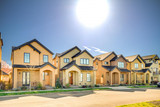It was no surprise to seasoned home builders when the Census Bureau reported in March a newer trend of people moving closer to the city and away from the suburbs. Rick McAlexander of Associated Designs in Eugene, Oregon has worked with hundreds of builders over the years to design houses for all types of neighborhoods. But, when Dane Butler of Future B Homes, also in Eugene, approached Rick about designing a series of single family homes for a growing, mixed-use development close to the urban core, Rick jumped right in. Rick has a passion for density housing, close to the city, and was happy to create his first collection of urban styled house plans, specifically created for a planned village development.
Dane Butler, president of Future B Homes, knew his urban village units needed a fresh concept in order to offer contemporary styled homes that most people could afford and realistically enjoy living in. “These kinds of homes should actually cost less to take care of with lower utility bills and less maintenance.”, Dane says.
After months of collaboration, Future B Homes began building a series of small footprint homes in a local development called Crescent Village. Rick created house plans for this project that have a north and south orientation. However, he situated the windows and patios on the home’s south side, which faces the neighbor’s adjacent exterior wall. This allows natural light to stream in throughout the home while offering privacy for each homeowner. After experiencing enthusiastic homeowner demand, Future B Homes has now built a total of 14 village style units out of a planned 26 for the mixed-use neighborhood.
The unique idea of an ‘urban floor plan’ attracts two types of clients, but for different reasons, according to Rick. He says some clients are keenly interested in living in a home with a smaller footprint. Other clients are driven primarily by economic benefits, because a smaller lot leads to lower development and construction costs, and lower maintenance bills. “Our clients get the best of both worlds with this plan”, says Rick, “whether the person is environmentally driven or conscious of cost”.
The concept of a planned urban village is not new. There are hundreds of examples of older, high-density neighborhoods in larger cities, like San Francisco and Seattle, or on the east coast in Boston and New York City. Even Charleston and New Orleans have long traditions of narrow homes built close to the street, right in the city. These types of dense neighborhoods were known to be highly livable during their heyday when individuals worked, shopped and socialized, within blocks of their home.
While Rick says he’s inspired by the lifestyles of yesteryear, fast forward about five decades and he’s incorporated significant differences in today’s urban house plan. First and foremost, homes are not attached by a shared wall. These plans offer more privacy, natural light and some amount of defined yard space. And, the homes are energy efficient and include amenities that are considered must-haves in today’s lifestyle. According to Dane, “With these plans, people find they have all the space and features they need with no wasted square footage.”
For example, Associated Designs has the ‘Parkview Plan 30-905’, where the house is only twenty-six feet wide and almost sixty feet long. The home is designed with an inviting entry court close to the street that could include a fenced privacy screen. A person can approach the home and take a right into the front door or turn left and head along the exterior wall toward an open or enclosed patio.
The first floor of this plan offers a contemporary, open kitchen with a great room layout, plus a master bedroom that includes a luxury bath and walk-in closet. The second floor accommodates three good-sized bedrooms and a two-door, shared bath with double sink. Add a 300 square-foot bonus room over the garage and the space lives large. The total living area is right under 2200 square feet with a footprint at just about 1500 square feet. Lot lines are approximately 3.5 feet from the exterior walls.
A developer doesn’t have to build a whole new village to utilize this style of housing. It works just as well when placed within undeveloped lots in older neighborhoods. It’s not uncommon in most cities to see well established neighborhoods from the turn-of-the-century, or mid-century, to include empty lots or houses in serious disrepair. City planners and developers both recognize the potential to convert weedy tracts into housing for people wanting to live closer to the city’s core. And, astute developers can turn several contiguous residential lots into a coordinated group of urban concept houses, each with a different plan but similar in styling. Dane notes that people who choose an urban village house tend to feel comfortable spending more time outdoors, enjoying a sense of community and neighbors.
There is a definite trend, says Rick, where people want to move closer to the city and cut their commute times while increasing access to urban amenities, city events and al fresco cafes. It’s about affordable and quality living, while working and playing in the same neighborhood – just like the old days, only better.
Recent Census Data Shows Urban Growth Supporting New Homes That are Small and Tall


